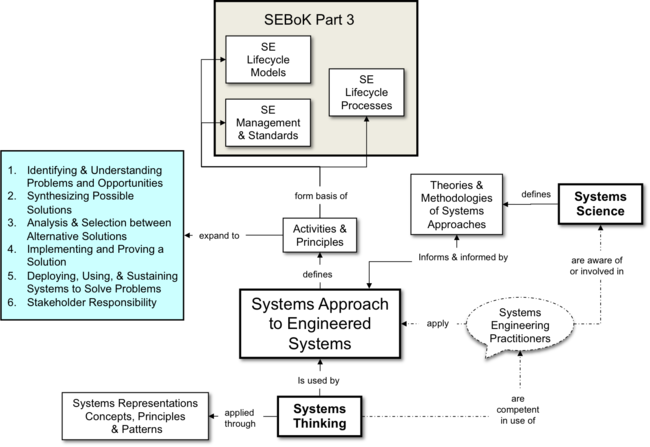Systems Approach Applied to Engineered Systems
This knowledge area (KA) provides a guide for applying the systems approach as a means of identifying and understanding complex problems and opportunities, synthesizing possible alternatives, analyzing and selecting the best alternative, implementing and approving a solution, as well as deploying, using and sustaining engineered system solutions. The active participation of stakeholders during all the activities of the systems approach is the key to the success of the systems approach.
In an engineered system context, a systems approach is a holistic approach that spans the entire life of the system; however, it is usually applied in the development and operational/support life cycle stages. This knowledge area defines a systems approach using a common language and intellectual foundation to ensure that practical systems concepts, principles, patterns and tools are accessible to perform systems engineering (SE), as is discussed in the introduction to Part 2: Systems.
Topics
Each part of the Guide to the SE Body of Knowledge (SEBoK) is divided into KAs, which are groupings of information with a related theme. The KAs in turn are divided into topics. This KA contains the following topics:
- Overview of the Systems Approach
- Engineered System Context
- Identifying and Understanding Problems and Opportunities
- Synthesizing Possible Solutions
- Analysis and Selection between Alternative Solutions
- Implementing and Proving a Solution
- Deploying, Using, and Sustaining Systems to Solve Problems
- Stakeholder Responsibility
- Applying the Systems Approach
Systems Approach
This KA describes a high-level framework of activities and principles synthesized from the elements of the systems approach, as described earlier in Part 2 of the SEBoK, and is mapped to the articles Concepts of Systems Thinking, Principles of Systems Thinking, and Patterns of Systems Thinking. The concept map in Figure 1 describes how the knowledge is arranged in this KA and the linkage to the KA in Part 3.
According to Jackson et al. (Jackson et al. 2010, 41-43), the systems approach to engineered systems is a problem-solving paradigm. It is a comprehensive problem identification and resolution approach based upon the principles, concepts, and tools of systems thinking and systems science, along with the concepts inherent in engineering problem-solving. It incorporates a holistic systems view that covers the larger context of the system, including engineering and operational environments, stakeholders, and the entire life cycle.
Successful systems practice should not only apply systems thinking to the system being created, but should also utilize systems thinking in consideration of the way in which work is planned and conducted. See Part 5: Enabling Systems Engineering for further discussions on how individuals, teams, businesses and enterprises may be enabled to perform systems engineering.
References
Works Cited
Jackson, S., D. Hitchins, and H. Eisner. 2010. "What is the Systems Approach?". INCOSE Insight. 13(1): 41-43.
Primary References
Checkland, P. 1999. Systems Thinking, Systems Practice. New York, NY, USA: John Wiley & Sons.
Hitchins, D. 2009. "What are the General Principles Applicable to Systems?" INCOSE Insight. 12(4).
Jackson, S., D. Hitchins, and H. Eisner. 2010. "What is the Systems Approach?" INCOSE Insight. 13(1): 41-43.
Additional References
Hitchins, D. 2007. Systems Engineering: A 21st Century Systems Methodology. Hoboken, NJ, USA: John Wiley & Sons.
Lawson, H. 2010. A Journey Through the Systems Landscape. London, UK: College Publications, Kings College.
Senge, P. M. 1990. The Fifth Discipline: The Art and Practice of the Learning Organization. New York, Doubleday/Currency.
SEBoK Discussion
Please provide your comments and feedback on the SEBoK below. You will need to log in to DISQUS using an existing account (e.g. Yahoo, Google, Facebook, Twitter, etc.) or create a DISQUS account. Simply type your comment in the text field below and DISQUS will guide you through the login or registration steps. Feedback will be archived and used for future updates to the SEBoK. If you provided a comment that is no longer listed, that comment has been adjudicated. You can view adjudication for comments submitted prior to SEBoK v. 1.0 at SEBoK Review and Adjudication. Later comments are addressed and changes are summarized in the Letter from the Editor and Acknowledgements and Release History.
If you would like to provide edits on this article, recommend new content, or make comments on the SEBoK as a whole, please see the SEBoK Sandbox.
blog comments powered by Disqus